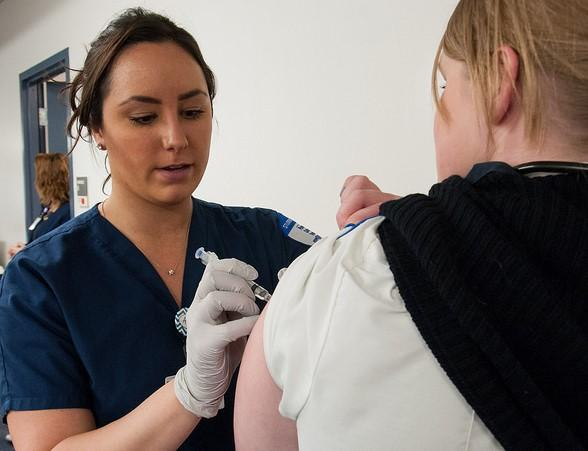A human-challenge randomized controlled trial, published last week in NEJM Evidence, finds that an mRNA (modRNA) influenza vaccine is 100% effective against both symptomatic and febrile flu, compared with 85% and 100% with the conventional quadrivalent (four-strain) influenza vaccine (QIV).
A team led by scientists from vaccine developer Pfizer conducted the phase 2a, double-blind trial by randomly assigning healthy adults aged 18 to 55 years in a 1:1 ratio to receive either a modRNA or QIV 30 days before exposure to A/H1N1 flu virus. Control participants from a separate trial were exposed to the same virus but were unvaccinated.
mRNA vaccines are more effective than egg-based vaccines and can be made more quickly, increasing the likelihood that they match circulating flu strains. The modified mRNA platform allowed vaccine makers to rapidly produce hundreds of millions of COVID-19 vaccine doses amid the pandemic.
Another flu vaccine trial published last week, this one a phase 3 study in the New England Journal of Medicine, also found better effectiveness with an mRNA than a control vaccine, with greater immune responses to the A/H3N2 and A/H1N1 strains but more side effects.
Lower viral load, good safety
The per-protocol cohort included 55, 48, and 52 participants in the modRNA, QIV, and control groups, respectively. Symptomatic flu occurred in 0%, 4.2%, and 26.9% of participants in the modRNA, QIV, and control groups, respectively, with a vaccine effectiveness (VE) of 100.0% for modRNA and 84.5% (95% confidence interval [CI], 43.4% to 96.0%) for the QIV, although the latter results had considerable uncertainty.
Overall, these data support the continued clinical development of the modRNA vaccine platform for protection against influenza.
Influenza with fever occurred in 0%, 0%, and 17.3% of participants in the modRNA, QIV, and control groups, respectively, with a VE of 100.0% (95% CI, 61.2% to 100.0%) for modRNA and 100.0% (95% CI, 55.9% to 100.0%) for QIV, although these results also had wide confidence intervals.
The median differences in the viral load (VL) area under the curve (AUC) between the vaccine and control groups were -88.66 for modRNA and -67.01 for QIV, again with some uncertainty. AUC is used to compare vaccine bioequivalence and estimated vaccine potency.
The median differences in peak VL between the vaccine and control groups were -4.52 for modRNA and -1.49 for QIV. There were no serious adverse events (AEs).
“In conclusion, in this human challenge trial, a single dose of modRNA vaccine was associated with fewer occurrences of laboratory-confirmed influenza infection and reduced VL,” the study authors wrote. “It was not associated with severe AEs, and it elicited immunogenic responses. Overall, these data support the continued clinical development of the modRNA vaccine platform for protection against influenza.”
Much more research needed before deployment
In an editorial in the same journal, Hana El Sahly, MD, and Robert Atmar, MD, both of Baylor College of Medicine, noted that during the 2024-25 US flu season, QIVs were estimated to be 36% to 54% effective in preventing related outpatient medical visits and 41% to 55% effective in preventing adult hospitalizations.
“Short of developing a universal influenza vaccine with effectiveness that spans multiple seasons and influenza subtypes, the development of seasonal influenza vaccines with improved effectiveness would constitute an important public health advance,” they wrote.
El Sahly and Atmar also cautioned that the trial was conducted among healthy young adults. “In most influenza seasons, older persons and those with coexisting illnesses are at highest risk for severe influenza, and school-age children have the highest disease incidence,” they wrote. “The enhanced mRNA vaccine protection against influenza A viruses in young adults is a step forward, but much remains to be achieved before enlisting mRNA vaccines in the annual fight against influenza.”





















